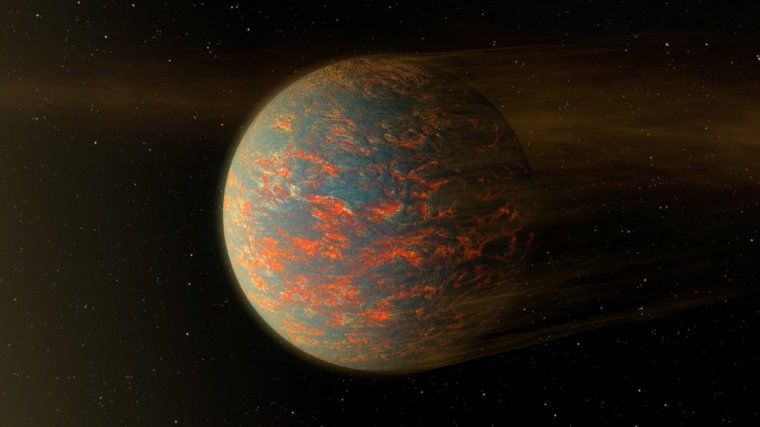| News / Space News |
Spitzer Maps Climate Patterns on a Super-Earth
NASA | MARCH 31, 2016
Observations from NASA's Spitzer Space Telescope have led to the first temperature map of a super-Earth planet -- a rocky planet nearly two times as big as ours. The map reveals extreme temperature swings from one side of the planet to the other, and hints that a possible reason for this is the presence of lava flows.

This illustration shows one possible scenario for the hot, rocky exoplanet called 55 Cancri e, which is nearly two times as wide as Earth. ![]()
The toasty super-Earth 55 Cancri e is relatively close to Earth at 40 light-years away. It orbits very close to its star, whipping around it every 18 hours. Because of the planet's proximity to the star, it is tidally locked by gravity just as our moon is to Earth. That means one side of 55 Cancri, referred to as the day side, is always cooking under the intense heat of its star, while the night side remains in the dark and is much cooler.
Spitzer stared at the planet with its infrared vision for a total of 80 hours, watching it orbit all the way around its star multiple times. These data allowed scientists to map temperature changes across the entire planet.
To their surprise, they found a dramatic temperature difference of 2340 degrees Fahrenheit (1,300 Kelvin) from one side of the planet to the other. The hottest side is nearly 4,400 degrees Fahrenheit (2,700 Kelvin), and the coolest is 2,060 degrees Fahrenheit (1,400 Kelvin).
The fact Spitzer found the night side to be significantly colder than the day side means heat is not being distributed around the planet very well. The data argues against the notion that a thick atmosphere and winds are moving heat around the planet as previously thought. Instead, the findings suggest a planet devoid of a massive atmosphere, and possibly hint at a lava world where the lava would become hardened on the night side and unable to transport heat.
Additional observations, including from NASA's upcoming James Webb Space Telescope, will help to confirm the true nature of 55 Cancri e.
YOU MAY ALSO LIKE


